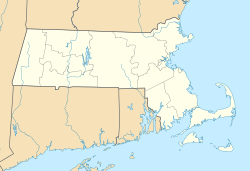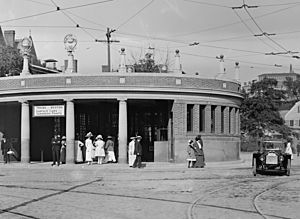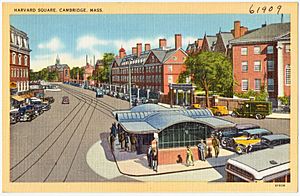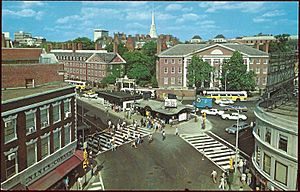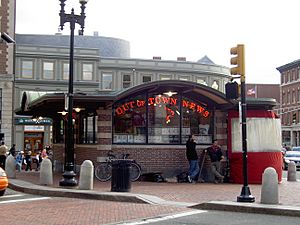Harvard Square Subway Kiosk facts for kids
Quick facts for kids |
|
|
Harvard Square Subway Kiosk
|
|
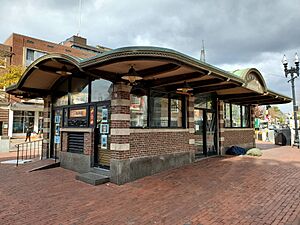
Harvard Square Subway Kiosk in November 2020
|
|
| Location | 0 Harvard Square Cambridge, Massachusetts |
|---|---|
| Area | Interior: ~500 square feet (46 m2) Roof: ~1,350 square feet (125 m2) |
| Built | November 1927–January 1928 |
| Architect | Blackall, Clapp & Whittemore |
| NRHP reference No. | 78000441 |
| Added to NRHP | January 30, 1978 |
The Harvard Square Subway Kiosk is a special historic building in Harvard Square in Cambridge, Massachusetts. It's a famous landmark that many people recognize.
This kiosk was built in 1928. It served as the main entrance to the Harvard Square subway station. The station had opened many years before.
In 1981, the subway station closed for big updates. The kiosk was then moved a little and fixed up. From 1984 to 2019, a popular newsstand called Out of Town News operated inside it.
The City of Cambridge owns the kiosk. After the newsstand closed, the city planned to use it for public purposes. The building was renovated and now serves as a visitors center.
Contents
History of the Harvard Square Kiosk
Building the First Subway Entrance
Long ago, people debated how to build a fast train line in Cambridge. In 1906, the Boston Elevated Railway (BERy) decided to build a subway from Boston to Harvard Square.
Work on the subway began in May 1909. The Cambridge subway opened on March 23, 1912. It connected Harvard Square to Park Street Under.
Early plans for Harvard Square included a large stone entrance building. This building was called a "headhouse." It was similar to ones in other parts of Boston. The first headhouse was a large oval-shaped building made of brick and stone. It also had smaller entrances around the square.
Why the First Entrance Changed
Even though it was new, the first headhouse soon faced problems. By 1919, people started to complain. It was so big that drivers couldn't see other cars coming. Also, there wasn't enough space for people to wait for streetcars.
In 1921, officials looked into replacing the headhouse. They found it would be too hard to remove it completely. However, they said Cambridge could build a smaller one if the city paid for it.
A professor named Charles B. Breed studied the headhouse in 1925. He suggested making it much smaller, covering only one exit escalator and one set of stairs. His design was very practical but not very pretty. People didn't like it, saying it looked like an "outhouse."
Designing the New Kiosk
In November 1925, a famous architect named Clarence H. Blackall joined the project. He helped design a new, better-looking headhouse. The Cambridge City Council approved his design in February 1927.
Construction for the new entrance began in November 1927. It was finished quickly, by January 1928. This new building is the kiosk we see today.
The new headhouse was smaller than the old one. It measured about 15.5 by 36 feet. Its roof was about 30 by 44 feet. It had two main parts: one for exiting and one for entering. An escalator and a walkway were between them.
The building had an industrial style but fit well with the older buildings in Harvard Square. It used steel pillars covered in limestone and bricks from the old headhouse. The walls were low, with special wire glass above them. This glass let drivers see through the building. The copper roof had a unique curved shape. People liked the "artistic appearance" of the new kiosk much more than the old one.
Kiosk Becomes a Landmark
Over the next ten years, signs saying "HARVARD SQUARE" were added. Later, in the 1940s, signs on the roof advertised "Rapid Transit to All Points."
In the 1960s, the kiosk started to be seen as a very important symbol of Harvard Square. An architecture critic even called it "probably the most important space in Harvard."
In 1967, the subway line became known as the Red Line. The transit authority planned to extend the Red Line. This meant big changes for Harvard Station.
To protect the kiosk, the Cambridge Historical Commission nominated it for the National Register of Historic Places (NRHP). This special list helps save important historical places. The kiosk was added to the NRHP on January 30, 1978.
In 1977, the transit authority agreed to save the kiosk. They planned to take it apart during construction and then put it back together. It would then be used as a newsstand.
Harvard station closed for rebuilding on January 31, 1981. The kiosk was carefully taken apart in February. Its copper roof, bricks, and limestone were stored safely. In 1983, the City of Cambridge became the owner of the disassembled kiosk.
The Famous Out of Town News
Out of Town News was a very famous newsstand. It was started in 1955 by Sheldon Cohen. He was known as the "unofficial mayor of Harvard Square."
The newsstand was special because it sold newspapers and magazines from all over the world. Many were flown to Boston to be available just one day after printing. People, especially professors and students, loved getting the latest news from their hometowns or from places where big events were happening.
Many famous people visited Out of Town News. John Kenneth Galbraith and Julia Child were regular customers. Even Robert Frost once asked for directions there.
A young programmer named Paul Allen bought a magazine there in 1975. This magazine inspired Allen and his friend Bill Gates to start Microsoft.
In 1984, Out of Town News moved into the old subway kiosk building. The kiosk had been moved a few feet north of its original spot.
In 1994, Sheldon Cohen sold the newsstand. It kept its name and unique way of selling news. People worried about the kiosk's future. A group asked to make it a protected landmark, but officials felt its lease already offered enough protection.
Changes and New Plans for the Kiosk
By 2008, the newsstand faced challenges. People could read news online, so buying yesterday's newspapers became less popular. The building also needed a lot of repairs.
In 2009, a new owner took over. They added more typical magazines and convenience store items. But they kept the original "Out of Town News" name.
The City of Cambridge began studying the kiosk's future in 2013. They considered fixing it up or changing its use. The newsstand's long-term lease ended in 2016. The city then used a short-term lease while deciding what to do.
In 2016, the city announced plans to turn the kiosk into a public space with glass walls. Another citizen group asked to make the kiosk a protected landmark again. This would stop the city's renovation plans. In November 2016, the Cambridge Historical Commission agreed to study this idea.
Out of Town News closed its doors on October 31, 2019. For a while, temporary artwork was displayed inside the kiosk. The building has since been renovated. It now serves as a visitors center, which was completed in April 2023.
See also


